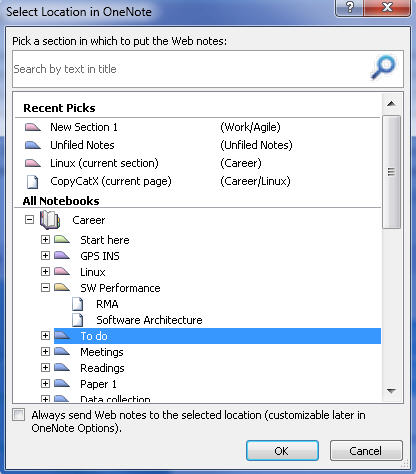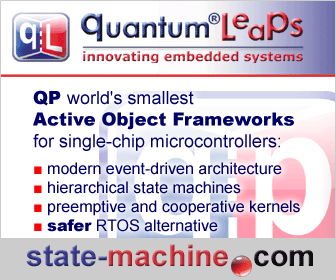|
|
||||||||||||||||
You may redistribute this newsletter for noncommercial purposes. For commercial use contact jack@ganssle.com. To subscribe or unsubscribe go to https://www.ganssle.com/tem-subunsub.html or drop Jack an email. |
||||||||||||||||
| Contents | ||||||||||||||||
| Editor's Notes | ||||||||||||||||
Did you know it IS possible to create accurate schedules? Or that most projects consume 50% of the development time in debug and test, and that it’s not hard to slash that number drastically? Or that we know how to manage the quantitative relationship between complexity and bugs? Learn this and far more at my Better Firmware Faster class, presented at your facility. See https://www.ganssle.com/onsite.htm. If you're a fan of the history of this field, here's a nice site with a collection of info about old microprocessors. |
||||||||||||||||
| Quotes and Thoughts | ||||||||||||||||
A programming language is low level when its programs
require attention to the irrelevant. - Alan J. Perlis |
||||||||||||||||
| Tools and Tips | ||||||||||||||||
Please submit neat ideas or thoughts about tools, techniques and resources you love or hate. There's been a ton of feedback about ways to preserve random bits of information. Carl Peterson wrote:
Olav Haugan sent this:
And Jeff Barth submitted:
David Fernandez Pinas's approach is:
Jeanne Petrangelo wrote:
Mike Skrtic channels Windows 3.11:
Tony Garland likes Trunknotes and Vimwiki:
After my review of the Analog Discovery USB scope, Brent Knecht sent in this warning:
|
||||||||||||||||
| What I'm Reading | ||||||||||||||||
An astonishing number of SCADA systems are vulnerable. Are there only four companies capable of making the most advanced chips? Free book on analog design.
|
||||||||||||||||
| Best C Book? | ||||||||||||||||
Greg Feneis wrote wondering what is the best C reference? He likes Teach Yourself C, Second Edition by Herbert Schildt (1994) and wonders about C11 books. My go-to references are the C99 standard itself, and K&R's The C Programming Language, Second Edition. What are your favorites? The embedded compiler vendors I've spoken to say that they don't plan to support the new C standard for at least a couple of years. |
||||||||||||||||
| The Seven Habits of Highly Dysfunctional Developers | ||||||||||||||||
Here are a few ways of maximizing your job security through proper dysfunctional design and management of your next embedded project. OverpromiseMake promises you know you can't keep. This cardinal rule is most effective when applied to scheduling. It's notoriously difficult to create a schedule that is accurate, so don't worry, be happy, wing it. One perfect indicator of an impossible schedule is that sick feeling one gets in the gut when moving Pert chart triangles around in an effort to meet marketing's arbitrary deadline. When you find yourself fudging data to meet expectations you know you're on track to mastering the art of overpromising. When you whisper lots of "maybes", "I hopes", and "ohmygods"; when miracles are expected and required, then your overpromising skills are truly in the upper percentiles of the dysfunctional. The most dysfunctional development groups have perfected this to a fine art, at times even bursting into loud guffaws when management requests a schedule or a progress update. Never limit your overpromising practice to schedules! Embedded systems are singularly subject to the merits of overpromising on system performance. Always promise that a 1 MHz 8051 will suffice. Always promise data transfer rates that press the state of the art. Defer Hardware IssuesSometimes the most frustrating part of getting your code to work is making it interface to the system's hardware. There's no sense in getting upset at the beginning of a project when you know that the end will be a disaster anyway, so always defer dealing with hardware requirements until you've written many thousands of lines of hardware-dependent code. Though modern C compilers are quite efficient even at handling low level tasks like talking to the hardware, proper convoluted design requires writing all drivers in assembly language. Minimize documentation and maximize obfuscation to enhance your job security. The hardware engineers will surely be happy to respin the board design as often as required, especially if the changes are requested within a week of final delivery. When it's time to assign blame, remember that modern FPGA design means the hardware is now just like the software - it's never done. Ignore Real TimeNever address real time issues until the night before delivery. Deferring performance problems, in particular, will assist in following the previous rule (Defer Hardware Issues), particularly if your code is so slow you'll have to replace the 8051 main CPU with a quad core Pentium-class machine. Some of the most successful dysfunctional developers have managed to create systems without an RTOS, and then convince their bosses to shoehorn the RTOS in only at the last minute. Be sure to convince your boss that no commercial RTOS is quite right for your application. Writing your own will fill many a lonely evening. Customers will delight in finding the subtle bugs sure to be left behind in the final executable. Since an application that is properly segmented into multiple tasks differs so much from the standard stream of consciousness approach, shoehorning an RTOS into your system late in the game will potentially add years to the project and to your job security. Glorify GlobalsUse lots of global variables. Every module should be dependent on variables from every other module. Make use of today's powerful tools which impose no penalty for the use of huge include files. Define every variable within the include file, so you won't have to worry about remembering which one is used where. It doesn't hurt to use cryptic naming conventions as well, to obfuscate the origin and influence of each global. Since the monster include will define variables with the most limited scope, yea even unto loop counters, remember that standard practice calls for expanding the old FORTRAN practice of naming temps. Use the names "i", "ii", and (my personal favorite) "iii", just appending "i"s as needed to create unique labels. Ignore the precepts of modern object oriented software design, which requires that variables be encapsulated within the functions that use them. Anyone who has done a complete OOP embedded project realizes just how much thought and planning is required to do so correctly. Take the easy approach now, since you know you'll be debugging forever anyway. Remember that "maintenance" is nothing more than an abstract concept touted by overpaid programming gurus, since most software never makes it to the field anyway. A frequently overlooked benefit of globals is their profound influence on your personal job security. Creating alarming numbers of dependencies in your code surely leads to the company being forever dependent on your skills. Discourage UnderstandingSoftware is complex. Few of us will ever understand a chunk of code over 50k lines. Bear in mind that software consultants tell us we should keep functions under a page as that's all the average programmer can comprehend. Since the history of the industry shows us that most software folks just start writing the code before bothering with a detailed design, it's clear that functions will always exceed a page. Sometimes the length of a single function may rival War and Peace. Given this fact, it seems unlikely that we'll ever understand the code anyway, so just go ahead and crank out C. As fast as possible. Besides, since the firmware will surely take longer than expected to complete, it's best to get started immediately. Most embedded systems run into trouble during debugging. One common problem includes synchronizing with external hardware. The wise practitioner will include a delay routine, whose input parameter is a delay time in arbitrary units. Sprinkle calls to the delay liberally into all hardware-centric activities. Tune the delay parameter until the unit works (working is the only measure of success). UNIX programmers are intimately familiar with the concept of a "magic number". We should extend it to all aspects of embedded code. A particularly appropriate place for magic numbers is in the programming of complex peripheral chips. Be sure, though, to add comments as required. For example: outp(0x3ab2, 0x33); /* program port */ Modern debugging tools promote our lack of understanding of deep problems. Once, when an edit-compile-debug cycle took hours, programmers were careful to be sure they had considered all possibilities before fixing a bug. This is no longer required. As soon as a problem surfaces, change something - anything - and recompile. It'll take but a few seconds, and with luck the change just might have the desired effect. Tuning the code with magic numbers and poorly thought out bug fixes enhances your career prospects. Quit and become a consultant to your old company, and enjoy many years of bountiful income from additional tuning and hacking. Neglect StandardsA quick glance through the literature shows hundreds of ideas for improving software productivity. Code inspections, methodologies, design reviews, and the like are the darlings of the gurus. But all are boring. All take time away from the thrill of coding, the excitement of debugging, and the roller-coaster-like terror of watching deadlines flash by. The Software Engineering Institute defines the Capability Maturity Model (CMM), which gives five levels of software maturity, as follows: 5. Optimizing - Characterized by Continuous Improvement. The organization has quantitative feedback systems in place to identify process weaknesses and strengthen them pro-actively. Project teams analyze defects to determine their causes; software processes are evaluated and updated to prevent known types of defects from recurring. 4. Managed - Predictable. Detailed software process and product quality metrics establish the quantitative evaluation foundation. Meaningful variations in process performance can be distinguished from random noise, and trends in process and product qualities can be predicted. 3. Defined - Standard and Consistent. Processes for management and engineering are documented, standardized, and integrated into a standard software process for the organization. All projects use an approved, tailored version of the organization's standard software process for developing software. 2. Repeatable- Intuitive. Basic project management processes are established to track cost, schedule, and functionality. Planning and managing new products is based on experience with similar projects. 1. Initial - Ad hoc and Chaotic. Few processes are defined, and success depends more on individual heroic efforts than on following a process and using a synergistic team effort. Clearly, though, level 1 is far too high of a standard for the most defective development projects. Fortunately Captain Tom Schorsch of the U.S. Air Force realized that the CMM is just a subset of the true universe of development models. He discovered the CIMM - Capability Immaturity Model - which adds four levels from 0 to -3: 0. Negligent - Indifference. Failure to allow successful development process to succeed. All problems are perceived to be technical problems. Managerial and quality assurance activities are deemed to be overhead and superfluous to the task of software development process. -1. Obstructive - Counter Productive. Counterproductive processes are imposed. Processes are rigidly defined and adherence to the form is stressed. Ritualistic ceremonies abound. Collective management precludes assigning responsibility. -2. Contemptuous - Arrogance. Disregard for good software engineering institutionalized. Complete schism between software development activities and software process improvement activities. Complete lack of a training program. -3. Undermining - Sabotage. Total neglect of own charter, conscious discrediting of peer organizations software process improvement efforts. Rewarding failure and poor performance. Strive for level -3 compliance to maximize project duration and thus your own job security. Abandon DisciplineAbandon all discipline when the end of the project draws near. If, perhaps though mistaken non-observance of the preceding rules, you happen to have employed software standards, or code reviews, or a scientific design methodology, be sure that as soon as the boss cranks up the pressure you drop all pretense of careful engineering. Just crank that code! After all, we know that pilots, when late in pushing back from the gate, always decide to skip the take-off check list. |
||||||||||||||||
| Jobs! | ||||||||||||||||
Let me know if you’re hiring embedded engineers. No recruiters please, and I reserve the right to edit ads to fit the format and intents of this newsletter. Please keep it to 100 words. |
||||||||||||||||
| Joke For The Week | ||||||||||||||||
Note: These jokes are archived at www.ganssle.com/jokes.htm. Jon Titus sent the following: A wife asks her engineer husband, "Could you please go shopping for me and buy one carton of milk? And if they have eggs, get six." A short time later the husband comes back with 6 cartons of milk and no eggs. The wife asks him, "Why did you buy six cartons of milk?!" He replied, "They had eggs." |
||||||||||||||||
| Advertise With Us | ||||||||||||||||
Advertise in The Embedded Muse! Over 23,000 embedded developers get this twice-monthly publication. . |
||||||||||||||||
| About The Embedded Muse | ||||||||||||||||
The Embedded Muse is Jack Ganssle's newsletter. Send complaints, comments, and contributions to me at jack@ganssle.com. The Embedded Muse is supported by The Ganssle Group, whose mission is to help embedded folks get better products to market faster. |






